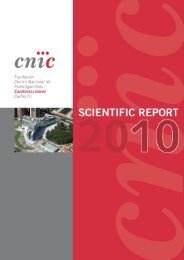Appendix - CNIC
Appendix - CNIC
Appendix - CNIC
Create successful ePaper yourself
Turn your PDF publications into a flip-book with our unique Google optimized e-Paper software.
SCIENTIFIC REPORT ´09<br />
Regulation of gene expression<br />
in vascular endothelium<br />
> RESEARCH INTEREST<br />
The calcium-calcineurin-NFAT (CN-NFAT) pathway regulates<br />
development of the immune, vascular and nervous systems,<br />
heart valve morphogenesis, and pancreatic beta-cell<br />
function, and is implicated in many related pathological<br />
processes. We study the regulation and function of CN-NFAT<br />
signaling in lymphocyte activation, angiogenesis and cardiac<br />
hypertrophy. Much of our work relates to molecular<br />
interactions of the phosphatase calcineurin with NFAT<br />
transcription factors and other substrates and regulators.<br />
This work has identified sequence motifs important for these<br />
interactions and sheds light on the mechanism of<br />
immunosuppressive drugs.<br />
Our work on angiogenesis addresses the regulation of NFAT in<br />
endothelial cells by VEGF and the profile and actions of<br />
prostanoids released by activated endothelium. We use<br />
retinopathy of prematurity (ROP) as a model of the<br />
mechanisms of neovessel formation in ischemic<br />
retinopathies, and are using lentiviral vectors to identify<br />
potential therapeutic targets. We are also analyzing the gene<br />
expression program triggered by angiotensin II (Ang-II) in<br />
cardiomyocytes and vascular smooth muscle and the role of<br />
CN-NFAT signaling in these processes. Likewise we are<br />
dissecting signaling pathways involved in abdominal aortic<br />
aneurysim (AAA) triggered by infusion of Ang-II in ApoE-/mice.<br />
A separate area of interest, directed by Dr. E. Cano, relates<br />
to the inflammatory reaction initiated by stroke. Cerebral<br />
ischemia triggers local production of inflammatory<br />
mediators, of which glial cells are an efficient source. This<br />
production sustains immune-inflammatory signaling if not<br />
halted by endogenous or exogenous anti-inflammatory<br />
agents. We are interested in the signaling pathways that<br />
contribute to lesion expansion, or conversely have a role in<br />
lesion containment and repair of the injured brain. In this<br />
context, we have been studying the role of calciumdependent<br />
pathways in astroglial cells.<br />
3 Vascular Biology and Inflammation<br />
Head of Laboratory: Juan Miguel Redondo Moya<br />
Research Scientist: Eva Cano<br />
Postdoctoral Researchers: Pablo Gómez del Arco<br />
Sara Martínez<br />
Aránzazu Alfranca<br />
Vanesa Esteban<br />
Predoctoral Researchers: Katia Urso<br />
Amelia Escolano<br />
Nerea Méndez<br />
Noelia Lozano<br />
39<br />
Technicians: Dolores López<br />
Felipe Were<br />
Isabel Mirones<br />
Ana Guio<br />
Gema Benito<br />
Raquel Sánchez<br />
Belén Ramírez<br />
Histological images of retinas from mice with oxygen-induced<br />
retinopathy (OIR). A, Hematoxylin-eosin stained sections from control<br />
(N) and OIR (Hx) mice; note the increase in the number of vessels in<br />
the inner plexiform layer (asterisks) and the presence of pre-retinal<br />
neovascularization (vascular tufts; arrows) in OIR retinas. B, Whole<br />
mount retinas from control (N) and OIR (Hx) mice. Vessels are stained<br />
with Isolectin B4 (red). Upper panels, non-infected retinas; Lower<br />
panel, retinas infected with GFP-encoding-lentiviruses. Note the<br />
avascular central areas (asterisks) in OIR retinas.



